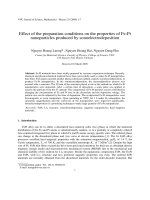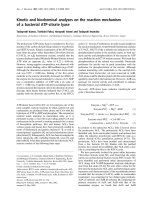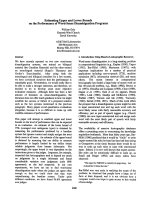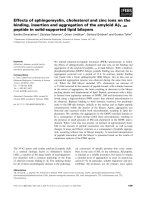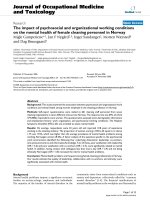effects of climate and ocean conditions on the marine survival of irish salmon (salmo salar, l.)
Bạn đang xem bản rút gọn của tài liệu. Xem và tải ngay bản đầy đủ của tài liệu tại đây (533.76 KB, 133 trang )
EFFECTS OF CLIMATE AND OCEAN CONDITIONS ON THE MARINE
SURVIVAL OF IRISH SALMON (SALMO SALAR, L.)
A Dissertation Presented
by
ARNAUD J. PEYRONNET
Submitted to the Graduate School of the
University of Massachusetts Amherst in partial fulfilment
of the requirements for the degree of
DOCTOR OF PHILOSOPHY
February 2006
Wildlife and Fisheries Conservation
UMI Number: 3206206
3206206
2006
Copyright 2006 by
Peyronnet, Arnaud J.
UMI Microform
Copyright
All rights reserved. This microform edition is protected against
unauthorized copying under Title 17, United States Code.
ProQuest Information and Learning Company
300 North Zeeb Road
P.O. Box 1346
Ann Arbor, MI 48106-1346
All rights reserved.
by ProQuest Information and Learning Company.
© Copyright by Arnaud J. Peyronnet 2006
All Rights Reserved
EFFECTS OF CLIMATE AND OCEAN CONDITIONS ON THE MARINE
SURVIVAL OF IRISH SALMON (SALMO SALAR, L.)
A Dissertation Presented
by
ARNAUD J. PEYRONNET
Approved as to style and content by:
_________________________________________________
Kevin D. Friedland, Chair
_________________________________________________
Robert DeConto, Member
_________________________________________________
Francis Juanes, Member
Niall O’Maoileidigh, Member
_______________________________________
Matthew J. Kelty, Department Head
Department of Natural Resources Conservation
iv
ACKNOWLEDGMENTS
This work was funded by a Marine Institute grant, under the Marine Institute and
NOAA Cooperation programme. I wish to express my gratitude to several people
who have been instrumental in helping me complete this research.
I thank my advisors, Kevin Friedland and Niall Ó Maoiléidigh, for helping me
design this study and conducting this research, and for their patience in reviewing
my writing.
I also wish to thank the other members of my committee, Francis Juanes and Rob
DeConto for always providing encouragement and assisting me.
I thank both Phil McGinnity and Sam Cushman who were always available to
discuss important aspects of this work and provided constructive comments and
suggestions.
I wish to thank our director in ACMS and President of NASCO, Ken Whelan, for
his help and support throughout this fellowship and for his infecting enthusiasm
about salmon angling. Many thanks also to the ACMS station manager, Russell
Poole, and his staff, for providing me with a tremendous administrative and
scientific support during my time in Furnace. Thanks to Ger Rogan, for his help
tracking information on Burrishoole salmon, for his great sense of humour and his
constant good spirit. Thanks also to all my other colleagues from the Marine
Institute, particularly Kathleen Sweeney and the rest of the ACMS team; but also
Glen Nolan in OSS for his support and advice on oceanographic data.
v
I am very grateful to all the individuals who provided data for this study: Jan-Even
Nilsen for the MLD Data; David Johns and Darren Stevens (both in SAHFOS) for
their help with CPR data; Rowan Fealy from NUI Maynooth; Aidan Murphy in Met
Eirann; Walter Crozier, Lars-Petter Hansen, Gudni Gudbersson, Lars Karlsson,
Julian McLean and Jacques Dumas for the time series of marine survival of
European salmon.
I would like to thank my parents, family and friends for their encouragements.
Finally my greatest gratitude goes to my wife Joanne, for her tremendous support
and wonderful patience during the last few years. This work is dedicated to her.
vi
ABSTRACT
EFFECTS OF CLIMATE AND OCEAN CONDITIONS ON THE MARINE
SURVIVAL OF IRISH SALMON (SALMO SALAR, L.)
FEBRUARY 2006
ARNAUD J. PEYRONNET, Bsc., UNIVERSITE BORDEAUX I
Msc., UNIVERSITY COLLEGE CORK
Ph.D., UNIVERSITY OF MASSACHUSETTS AMHERST
Directed by: Dr. Kevin D. Friedland
This dissertation investigates the role of climate and ocean conditions on the marine
survival of Atlantic salmon. The overall objective was to identify the relevant
environmental variables controlling salmon marine survival, in order to establish
predictive models of marine recruitment. These models are required to improve the
management process of the Irish and European salmon resources.
I first explored the levels of synchrony in the marine survival of European salmon,
in order to assemble evidence on the spatial scale of the processes controlling
survival. I demonstrate that these levels of synchrony are low and I conclude that
large scale events are not directly exerting a control on the rates of salmon survival,
perhaps indicating the presence of several intermediary processes.
Using information from a scale analysis of a monitored Irish population, I then
explore the hypothesis that marine survival is linked to marine growth. I present
evidence that the level of marine recruitment of 1SW salmon is linked to growth
during the marine residency, and that decreasing growth over the last 30 years
explains the observed decrease in salmon recruitment.
vii
Finally, I explore the role of several environmental variables on salmon marine
survival, by constructing semi-parametric models (GAMs) of marine survival for
wild and hatchery Irish populations. These models explain an important part of the
inter-annual variability in survival and provide a capability to forecast survival.
These models also help to identify the role of specific variables, more specifically
the North Atlantic Oscillation, sea surface temperatures, and the abundance of
zooplankton, to explain the variations in survival.
I conclude that the changes in climate in the northeast Atlantic have affected the
salmon via bottom-up effect, by affecting the abundance, distribution and
phenology of key zooplankton species in the northern North Sea and southern
Norwegian Sea.
Keywords: Atlantic salmon; Climate; GAM, Growth; Marine survival; NAO;
Ocean; Synchrony; Zooplankton.
viii
TABLE OF CONTENTS Page
ACKNOWLEDGEMENTS…………………………………………………… iv
ABSTRACT……………………………………………………… ……………vi
LIST OF TABLES……………………………………………………………….ix
LIST OF FIGURES…………………………………………………………… x
CHAPTER
1. INTRODUCTION……………………………………….……………… ……1
2. IS THERE COHERENCE IN THE MARINE RECRUITMENT OF
NORTHEAST ATLANTIC SALMON, SALMO SALAR, L.?
IMPLICATIONS FOR THE SPATIAL SCALES OF THE PROCESSES
CONTROLLING……………………………………………………… … 11
3. LINK BETWEEN MARINE GROWTH AND SURVIVAL OF IRISH
ATLANTIC SALMON (SALMO SALAR, L.)…………………………….…52
4. EFFECTS OF CLIMATE CHANGE ON SALMON (SALMO SALAR, L.)
MARINE RECRUITMENT IN THE NORTHEAST ATLANTIC………….76
5. CONCLUSION………………………………………………………………112
6. BIBLIOGRAPHY…………………………………… ………………… …117
ix
LIST OF TABLES
Table Page
2.1. Summary of the marine survival time series, the coordinates
of the point of entrance to the Sea, the methods used to generate
the data and information on the data holders and their affiliation…….… 44
2.2. Testing hypotheses on the structure of synchrony
in Marine survival of European salmon stocks………………………… 45
2.3. Matrix of inter-stocks distances (km)…………………………………….….46
2.4. Summary of pairwise cross-correlation coefficients
between aggregated stocks………….…………………………………… 47
2.5. Mantel tests results for synchrony versus distance
and other hypothetical models of synchrony organization……… …… 51
3.1. Correlation between growth indices and salmon recruitment………… ….73
4.1. Final GAM for Wild salmon survival and nested models…………… … 101
4.2. Numerical output from the model (GAM) of wild salmon survival….……102
4.3. Final GAM for Hatchery salmon survival and nested models…………… 106
4.4. Numerical output for the model (GAM) of hatchery marine survival…… 107
x
LIST OF FIGURES
Figure Page
2.1. Locations of the European salmon stocks for which time-series of
marine survival were used in a cross-correlation analysis.…………………43
2.2. Mean marine survival (and Standard Deviation), for all stocks of
hatchery (H) and wild (W) origins……………………………………….…48
2.3. Mean synchrony in marine survival for all European sub-groups (regions)…49
2.4. Cross-correlation versus inter-stocks distance for all pairs of stocks in the
northeast Atlantic…………………………………….…………………….50
3.1. Indices of Irish salmon recruitment………………………………………… 69
3.2. Mean decadal curves of inter-circuli distances
for Burrishoole Salmon ……………………………………………………70
3.3. Total marine growth, represented by the cumulative inter-circuli
distances, measured between the last freshwater circuli and the edge
of the scale………….…………………………… ….…………………….71
3.4. Total marine growth, represented by the total number of circuli
measured between the last freshwater circuli and the edge of the scale …72
3.5 Scatterplots of growth versus Burrishoole salmon recruitment………………74
3.6 Relationships between the total number of circuli and the numbers of
circuli at first point of maximum growth, first point of minimum
growth and second point of maximum growth…………………………… 75
4.1. Standardized mean marine survival for hatchery
4.2. Standard Continuous Plankton Recorder regions………………………… 100
4.3. Diagnostic plots for the GAM (Marine survival wild Irish salmon),
showing no violation of the assumption of normality (no pattern for the
fitted residuals) and no violation of the assumption of homogeneity
(QQ-plot).………………………………………………………………….103
4.4. Fitted (GAM) and observed values of wild marine survival……………….104
4.5 Scatterplots of dependent variables (explanatory) versus marine
survival for wild Irish salmon…………………………………… ………105
xi
4.6. Fitted (GAM) and observed values of hatchery marine survival ………….108
4.7. Scatterplots of dependent variables (explanatory) versus
marine survival for hatchery Irish salmon. ………………… ………… 109
4.8. Diagnostic plots for the GAM (Marine survival hatchery Irish salmon),
showing no violation of the assumption of normality (no pattern for the
fitted residuals) and no violation of the assumption of homogeneity
(QQ-plot)………………………………………………………………….110
4.9 Link between marine growth (circuli number) and marine survival
for Burrishoole Wild salmon………………………….………………… 111
1
CHAPTER I
INTRODUCTION
The last century has seen an extraordinary increase in the rate of development of the
western civilization, but it is the rates of industrial and economic expansion and
growth in human population that make it a turning point in human history. Both
development and demographic pressure have contributed to equally important
changes in the marine fisheries, from a localised coastal and artisanal activity to the
technologically advanced and globalised industry we know today. In the early days,
catches and yield increased according to the level of effort and the resources were
seemingly unlimited (Hjort 1914). We know today that all marine resources are
finite and can get rapidly depleted by fisheries activities. Fishing is responsible for
the collapse of single-species stocks but can also result in other pervading effects at
the ecosystem level, such as the removal of large predatory species (Ward and
Myers 2005) and the decrease in trophic levels (Pauly et al. 1998). Extreme cases of
over exploitation can even result in species extinction (Casey and Myers 1998).
Changing trends in fisheries science have followed the pattern of changes in the
industry. This very active and broad scientific discipline regularly provides new
methods and techniques for stock-assessment and management purposes. Perhaps
more importantly, it is the overall objectives and fundamental ideas that seem to
have evolved most. Sustainability is now central to the long-term management plans
of most commercial stocks (Rosenberg et al. 1993; Pauly et al. 2002). In addition, a
shift is taking place from single species consideration to an ecosystem approach
(Gislason et al. 2000). Another modern development is the acceptance of
2
uncertainty (Ludwig et al. 1993) and its implications for fishing activities.
Uncertainty derives from the complex nature of the marine ecosystems and our lack
of understanding or ability to conduct investigations at large spatial and temporal
scales. Further uncertainty is associated with environmental variability. The effects
of environmental variability on fish production seem to be receiving increasing
attention because of the widespread pattern of overexploitation of marine resources.
Indeed, the consequences of environmental variability are more serious for stocks
that are already depleted by fishing activities (Pauly et al. 2002). In the case of
exploited populations, the global stock production is often over reliant on strong
cohort recruitment, and this exacerbates the role of the environment. When
combined together, the global pattern of over-exploitation and the severe climatic
changes we are witnessing provide a very ominous context for the long-term
sustainability of many stocks (IPCC 2001; Walther et al. 2002). In this context of
over-exploitation of the majority of the commercial stocks, the variability due to
environmental conditions therefore appears to have an increasing influence over the
overall levels of abundance. The effects of environmental conditions on fish
abundance have been widely reported and continue to stimulate much interest
(Klyashtorin 1998; McFarlane et al. 2000; Finney et al. 2000; Klyashtorin 2001). In
the north Pacific, climate variations have been linked to trends in fish production
over the last 2200 years (Finney et al. 2002). Cycles of climate conditions and their
link to salmon production have also been identified over multi-decadal periods
(Hare and Francis 1995). These patterns are often detected through the presence of
periods of pronounced high/low production termed regimes and occurring
3
synchronously to similarly strong/weak climatic signals. Often, the biological
outcome of the climate patterns is reflected in the levels of production of several
species (Aebisher et al. 1990). The variation in the overall salmon abundance in the
north Pacific is mainly influenced by the state of these climate/production regimes
(Hare and Francis 1995; Beamish et al. 1997, 1999), rather than by the patterns of
production in freshwater. Similarly, the variations in the abundance of Atlantic
salmon are largely controlled by events taking place during the marine residency
(Chadwick 1987; Friedland et al. 2005). Over the last three decades, salmon
abundance in the north Atlantic experienced a strong decline, particularly the
southern populations (Jonsson and Jonsson 2004). This decline occurred in the
context of stable or increasing freshwater recruitment and reductions in the rate of
marine exploitation. Despite increasingly favourable conditions, adult returns
decreased significantly, indicating a global decrease in marine survival rates
(Parrish et al. 1998). This decrease in marine survival is thought to be linked to
changes in the climate and ocean conditions, with effects on the marine ecosystems
of the north Atlantic (Beaugrand and Reid 2003; Jonsson and Jonsson 2004;
Friedland et al. 2005).
Links between the environmental conditions and survival have been established,
with a particular focus on the early marine residency (Friedland et al. 2005). Rates
of marine survival have been linked to the extent of a favourable thermal habitat (a
range of prefered thermal conditions) early after the smolt migration (Friedland et
al. 1998, 2000). In years of warmer Sea Surface Temperatures (SST’s), survival for
a Scottish and a Norwegian population, both bordering the North Sea, were found to
4
be better than during colder years. The survival rates for the Scottish stock were
also linked to the growth rate of the postsmolts (Friedland et al. 2000). Survival for
Baltic populations is also positively correlated with SST’s in early summer (Kallio-
Nyberg et al. 2004). Jonsson and Jonsson (2004) suggested that increasing SST’s
could increase both food consumption and growth rate, and hence result in higher
survival. The patterns of decrease in salmon abundance in the 1980’s, and the fact
that it took place in the context of a well reported global increase in temperatures
(IPCC 2001), remains an important predicament to support this hypothesis.
Opposite relationships have been identified for north American populations, for
which abundance is negatively correlated with SST’s and thermal habitat in June
(Friedland et al. 2003). Negative correlations between salmon abundance and
temperature have also been reported in the northeast Atlantic (Beaugrand and Reid
2003). In this case, the increase in Northern Hemisphere Temperatures (NHT) is the
main explanation for the northward shift of the distribution of the copepod Calanus
finmarchicus, with effects on the pelagic ecosystem and on salmon. Such changes in
copepod abundance and distribution can result in lower growth rates, which in turn
have control on the overall survival rates. In Ireland, previous studies have indicated
the absence of a link between growth and survival for both the river Bush (Crozier
and Kennedy 1999) and the Burrishoole (McLoone 2000). However, links between
growth and recruitment have been reported for Pacific salmon (Beamish et al. 2004)
and for Atlantic salmon (Friedland et al 2000; Jonsson et al. 2003), hence providing
an indication of the mechanisms controlling survival.
5
Salmon fisheries taking place in the high sea are managed by the north Atlantic
Salmon Conservation Organisation (NASCO), whereas homewater fisheries are
under national jurisdiction In recent years, the management process for the Irish
salmon resource has seen considerable new developments, with changes in scope
and purpose of the stock assessment, the methodology of this assessment, and
finally the quality and the relevance of the advice delivered. Up to 2002, the
management regulations only affected the level of effort and were not based on the
status of the resource. A review of the management of the Irish salmon resource
(Anon. 1996) recommended that the management objective should be the
attainment of conservation limits (CLs) to ensure sufficient escapement of adult
spawners, rather than conservation of the resource via effort control. Total
Allowable Catch (TAC) was chosen as a technical instrument to ensure that the
conservation limits were attained for each salmon stock (i.e. fishery districts in
Ireland). Initially, these CLs were provided by pseudo stock-recruitment analyses,
following the methodology used by Potter et al. (1998). Both the pseudo-
recruitment and TAC setting-up approaches require information on the number of
fish returning to spawn. This information can be obtained using catch numbers,
which are modified to account for the levels of non-reported catches (local
expertise) and exploitation (derived from a Coded Wire Tagging programme,
Browne 1982), providing an index of Pre-Fishery Abundance (PFA). Once the
effects of natural mortality are accounted for, the number of spawners can be found
by subtracting the catches from the PFA. Run reconstruction models of PFA are
available for Irish 1SW fish since 1970 (Anon. 2003). In fisheries science,
6
Biological Points References (BRPs) are used to define safe levels of harvests.
When spawners numbers are considered with the lagged values for the resulting
recruits, stock-recruitment analysis can be conducted and the BRPs can be derived.
However, this approach has several limitations.
Firstly, the CLs are not river specific and correspond to district CLs. The attainment
of district CLs will not guarantee that each river can reach its conservation limit in
terms of spawning escapement. In order to overcome this problem, new methods
have been applied to determine CLs for each river. There are only few monitored
rivers for which stock-recruitment analysis can be conducted. This is because the
monitoring of these rivers generally requires a substantial and costly effort.
However, a new methodology has been implemented, where the BRPs can be
transferred from monitored to non-monitored systems. The BRPs for the non-
monitored rivers are modified to account for differences in latitude of the river
(with both climatic and ecological (Hutchings and Jones 1998) implications) and
the total wetted area available (Prevost et al. 2003).
Secondly, under the present stock/recruitment and catch advice processes, the
advice is delivered using information from catches in previous years, and without
consideration for the conditions in the marine environment. The PFA model used in
the northeast Atlantic is a run-reconstruction model using past information on
catches. A pro-active approach requires forecasting PFA according to the number of
spawners in the previous years (or to an index of juvenile abundance), and to
marine conditions. A similar forward running model has been established in the
northwest Atlantic, based on the number of spawners and sea temperatures in the
7
spring, but the relationship with the thermal habitat did not hold (Crozier et al.
2003). A forecasting model of PFA has several advantages over the present back-
calculated model. It allows one to predict returns, according to the conditions in the
marine environment, and to provide advice before the fishing season, on the basis of
a realistic assessment of the status of the stock. In addition, it can also help to
formulate advice for the high sea fisheries of West Greenland and the Faroes.
Finally, as more fisheries close and fishing effort declines, the quality of the back-
calculated index of PFA (which relies on good catch information) is decreasing. A
predictive model based on spawners numbers/juveniles and environmental
conditions would not be affected by these limitations. The development of such a
forecasting model for PFA has been considered, but so far our understanding of the
relationships between climate and marine conditions has not been strong enough to
construct such a model (Crozier et al. 2003). This study was designed to explore
more explicitly the links between the marine conditions and the levels of
recruitment for Irish populations.
The index of PFA is central to the delivery of the scientific advice for catches of
Irish salmon. A forecasting model of PFA, based on levels of juvenile production
and environmental conditions, can improve the accuracy of the advice by making it
a pro-active rather than a reactive process. Time series of marine survival are
available for several European rivers, usually as a result of trapping and/or tagging
programmes. The number of fish returning to freshwater is compared to the total
number of smolts migrating the previous year. This proportion is then raised to
account for the rates of exploitation by the coastal fishery and for the rate of non-
8
reported catch, hence providing a percentage of returns to the coast, or marine
survival. Since the early 1980’s, these indices display important inter-population
and inter-annual levels of variability. However, a common declining trend is present
for nearly all these populations. This variability can be an indication of the diversity
of the processes controlling survival. Alternatively, the global decline in
recruitment, also observed on the time-series of PFA, seems to suggest that large
scale climate/ocean processes are involved. These large-scale events can have
different outcomes, by demonstrating disparity in amplitude between
geographically distinct regions. For a given wide-scale process, the effects on
salmon survival will be decided through interactions taking place in the specific
context of the local ecosystem conditions. These large-scale events are unlikely to
directly control salmon survival, but it is the number of intermediary processes, and
their nature, that will dictate their relevance as a predictor for salmon recruitment.
In order to limit the number of potential predictors, it would be useful to get an
insight into the spatial scale of these events/processes. A similar approach has been
used to identify the factors controlling the marine recruitment of Pacific salmon
(Oncorhynchus spp.) (Pyper et al. 2001, 2002; Mueter et al. 2002, 2005). The levels
of coherence/synchrony in marine survival between distant populations were used
to infer the spatial scale of the factors controlling survival. The idea being that if
survival is controlled by basin-wide (northeast Atlantic) processes, there should be
important similarities in recruitment rates between populations, even at large
distances. Alternatively, a lack of synchrony could be a reflection of differences in
life-history traits between populations (e.g. proportion of multi sea-winter),
9
differences in the timing ( or the occurrence of distinct factors controlling the
survival of the various populations (i.e. presence of lags due to the number of
intermediary processes).
In the first chapter, I compare the inter-annual variation in the rates of marine
survival of 18 European populations using cross-correlation analysis. The patterns
of coherence in marine survival across Europe and their link with geographic
distances are further explored through the use of Mantel tests. I demonstrate that
there is little synchrony in marine survival, and that similar results also arise from
the analysis of coherence of the longer time-series of PFA. Several potential
interpretations are provided as well as their consequences for the study of the
factors controlling survival.
In the second chapter, I investigate the nature of the link between marine growth
and marine recruitment for a monitored Irish population over four decades. Scales
from 1SW Burrishoole salmon were used to create indices of marine growth that
were compared to rates of marine survival and return to the coast. A strong link
between marine growth and marine survival is demonstrated and its importance to
understand the mechanisms controlling recruitment is discussed.
Finally, in the third chapter, I produce semi-parametric models of marine survival
for Hatchery and Wild Irish salmon, based on the selection of both linear and non-
linear predictors, using Generalized Additive Models (GAM). The most relevant
and parsimonious GAM explain a large amount of the variability in survival of Irish
Hatchery and Wild populations. These models provide an insight into the role of
particular predictors, and their relevance is interpreted. More specifically, the
10
variability in survival seems to result from the synergetic effects of climate change
on the pelagic ecosystem of the northeast Atlantic.
11
CHAPTER 2
IS THERE COHERENCE IN THE MARINE RECRUITMENT OF NORTHEAST
ATLANTIC SALMON, SALMO SALAR L.? IMPLICATIONS FOR THE
SPATIAL SCALES OF THE PROCESSES CONTROLLING SURVIVAL.
Abstract
The levels of inter-annual synchrony in marine recruitment of 18 European
populations of Atlantic salmon were examined, in order to determine the spatial
scales of the processes regulating marine survival. A series of hierarchical
hypotheses were formulated and tested to examine the patterns of synchrony across
the northeast Atlantic. Time series of marine survival and pre-fishery abundance
both indicated that, despite common declining trends, inter-annual synchrony
between populations is poor. This result would suggest that processes operating at
the scale of the northeast Atlantic may have control over the survival rates, but their
effect on inter-annual variation is suppressed or modulated by other processes. Nor
was evidence found supporting the hypothesis of control at the coastal level.
Instead, our results suggest the existence of a combination of factors that are
specific to each population and thus possibly reflecting the importance of events
taking place before the stocks overlap at sea, and perhaps in freshwater.
Keywords: Atlantic salmon; marine survival; Mantel tests, recruitment; synchrony;
spatial scale.
12
Introduction
In the last thirty years, the total reported catch of salmon in the north Atlantic
decreased more than four fold, from approximately 12,000 tonnes in 1972 to 2,625
tonnes in 2002 (Anon. 2003). Management measures have contributed to reduce the
catches but the overall pattern points towards a decline in marine survival (Anon.
2002; 2003).
Initially, the patterns of salmon recruitment were considered to be primarily driven
by density-dependent processes taking place during the juvenile freshwater
residency (Chadwick 1985). More recent studies have revealed that the overall
salmon recruitment is in fact largely a result of the variability in survival during the
marine rather than the freshwater part of the life cycle (Chadwick 1987; Bradford
1995; Friedland et al. 2003), because survival during the freshwater phase exhibits
less variation than the marine survival.
This recent shift of interest from the freshwater to the marine environment has
highlighted the existence of important gaps in our knowledge of the ecology of
salmon at sea. From a management point of view, and in the context of dwindling
stocks, it is important to understand the processes responsible for the regulation of
salmon populations in the marine environment. This requires the understanding of
the spatio-temporal scale of the processes controlling salmon survival, in order to
establish the role of potential predictor variables upon salmon recruitment, which
might lead to more informed management of the exploitation.
In the north Pacific, several studies have considered temporal synchrony (or co-
variation) in survival, for species of Oncorhynchus originating from different
13
regions, to be indicative of the spatial scale at which marine survival was regulated
(Peterman et al. 1998; Pyper et al. 2001; Mueter et al. 2002; Pyper et al. 2002;
2005). These studies have shown that coastal processes controlled survival for these
species (Peterman et al. 1998; Pyper et al. 2001; 2002; 2005). This contradicts
previous studies suggesting that marine survival was determined via basin-wide
processes (Beamish and Bouillon 1993; Noakes et al. 1998; Beamish et al. 1999).
Intuitively the amplitude of the pattern of decline in the recruitment of Atlantic
salmon (i.e. the fact that it affects all the populations across the salmon range)
suggests that the recruitment is likely to be controlled by events taking place in the
marine environment, where and when the stocks can be found together. For
instance, the survival of stocks from Scotland and Norway has previously been
linked to the extent of favourable thermal habitat in the North Sea (Friedland et al.
1998, 2000). The level of synchrony between populations could help us to
conceptualise and test further hypotheses regarding the process controlling survival
at sea. Synchrony in inter-annual recruitment of northeast Atlantic salmon has been
reported for two sets of geographically close pairs of populations, The North Esk
(Scotland) and the Figgjo (Norway) (Friedland et al. 1998), and the Teno and the
Näätämöjoki
(both from Finland) (Niemelä et al. 2004). Comparisons between
populations from the northeast Atlantic have also been conducted (Crozier et al.
2003; Potter et al. 2004), however, the implications for the spatial scales of the
regulating process were not explored.
To examine whether salmon populations display coherence in recruitment
variability on an inter-annual basis, the levels of synchrony in recruitment for
